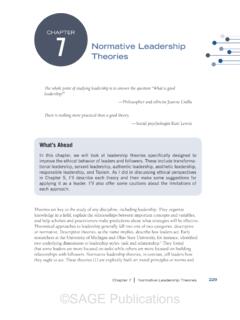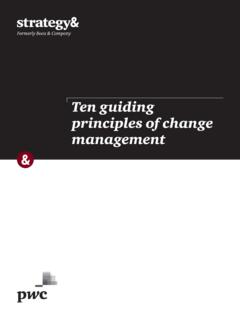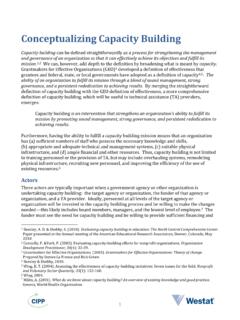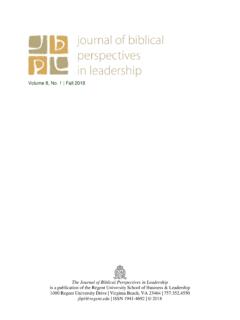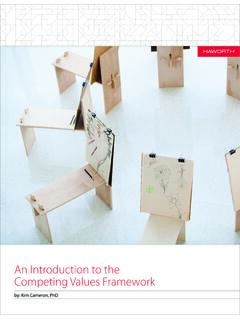Transcription of Situational Leadership Theory as a Foundation for a ...
1 Journal of Education and Practice ISSN 2222-1735 (Paper) ISSN 2222-288X (Online) , , 2016 25 Situational Leadership Theory as a Foundation for a Blended Learning Framework David Meier Research Scholar, National School of Leadership , Pune, India Abstract Ultimately with the raise of computer technology, blended learning has found its way into teaching.
2 The technology continues to evolve, challenging teachers and lecturers alike. Most studies on blended learning focus on the practical or applied side and use essentially pedagogical concepts. This study demonstrates that the Leadership sciences can enrich pedagogy in building a framework for teaching in a blended learning setting. At the core, the study transforms Situational Leadership Theory (Hersey, Blanchard and Johnson, 2008) into a framework for blended learning.
3 The model presented helps in organizing a situationally correct employment of blended learning and crystallizes appropriate teaching methods for specific learning goals. Keywords: blended learning; Situational Leadership ; teaching; adult education Introduction Integrated or blended learning provides a multitude of new opportunities for knowledge acquisition, knowledge sharing and knowledge organization. Due to the rapid development of technology in the field of blended learning, the Theory mostly covers a best practice approach (Thorne, 2003, or Garrison, 2008).
4 This means that while blended learning is widely used, there does not yet exist many generally accepted theoretical concepts of deployment, and none that tries to combine educational theories with Leadership theories. The approach presented here constructs a framework where blended learning is put into a theoretical and pedagogical context. But importantly, the focus extends the field of pedagogy. Lecturers or trainers are also leaders; they need to lead and guide their students to acquire knowledge.
5 This becomes more important in environments where one is confronted with adults, as is the case at universities and in adult education generally. And because the learning and teaching are taking place under diverse settings, the approach presented here incorporates the Blanchard and Hersey (2008) Situational Leadership Theory . In their original Theory , Blanchard and Hersey (1977) distinguished different styles of Leadership and several maturity levels. Looking into a learning framework like blended learning one is not confronted with Leadership styles, but rather with teaching or learning styles as described by Akkoynulu and Soylu (2008) in their research on blended learning and different learning styles.
6 Therefore one of the crucial parts of this study is the transformation of Leadership styles into teaching styles. Definition of Terms When researching the term blended learning, it is readily noticeable that there is no independent definition of blended learning. In the words of Picciano (2014), a definition is not even possible. Different definitions exist simultaneously. The definition provided here is an attempt to articulate the writer s own view of what blended learning really is.
7 Blended learning is a rather new concept and has not yet taken hold as a generic term. It seems that one important attribute is its differentiation from e-learning. The latter also is a new, imprecise term. Its lowest common denominator is the computer as a means of knowledge diffusion through computer-aided learning. At the core of blended learning, there is the postulate of networked learning and teaching. Depending on one s perspective, blended learning extends e-learning or is merely one of several e-learning methods.
8 Blended learning combines different teaching and learning methods, and certainly a strong emphasis is placed on e-learning. Location-independent learning platforms connected with the Internet are most often what is directly meant when talking about blended learning. But this is not absolutely necessary, as is shown with yet another term m-learning or mobile learning. There the emphasis is for sure on mobility and hence more concretely on the Internet. Blended learning can integrate web-based training contents (WBT) and computer-based training contents (CBT), but does not necessarily have to do so.
9 For the sake of completeness, there are two more terms to mention e-tutor and e-mentor both of which focus on accompanied learning on virtual platforms, mostly in the form of learning management systems (LMS) or, better, e-learning management systems (ELMS). Summarized, the key concepts can be put together thus: a. E-learning - computer technology as a medium of knowledge transfer b. Webbased training (WBT) - E-learning via the web; the advantage lies in the local independence c. Computer-based training (CBT) - E-learning with stand-alone applications on a local PC d.
10 E-tutor and e-mentoring - Learning support through virtual learning platforms e. Learning Management System (LMS) An integrated virtual learning platform, mostly web-based Journal of Education and Practice ISSN 2222-1735 (Paper) ISSN 2222-288X (Online) , , 2016 26 Didactics and Blended Learning In the context of this article, didactics is the theoretical and practical framework of teaching and learning.










